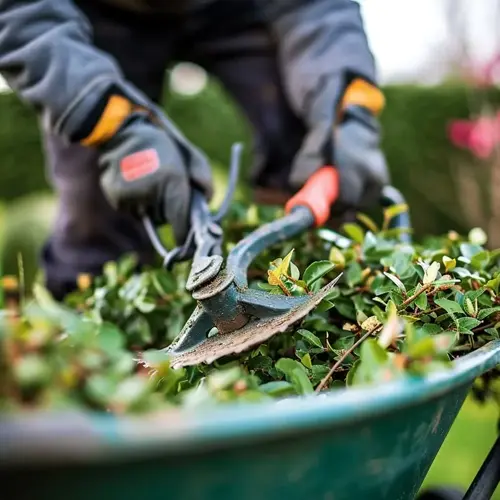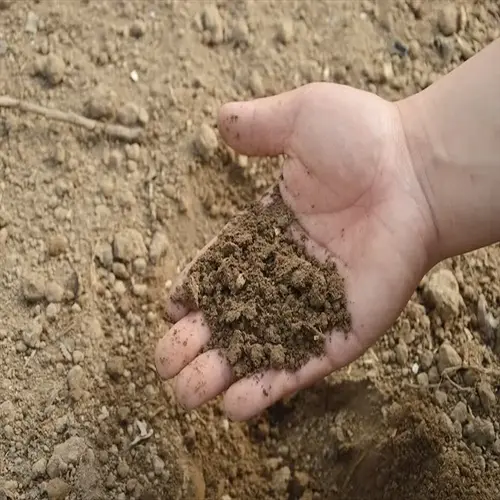Best Tomato Companion Plants

Written by
Nguyen Minh
Reviewed by
Prof. Martin Thorne, Ph.D.Companion plants for tomatoes provide natural pest deterrents and act as growth enhancers through the plant's symbiotic relationships.
Basil enhances the flavor of tomatoes when planted as tomato companion plants and also discourages whiteflies.
Marigolds serve as tomato companion plants that help suppress soil dwelling nematodes, thus protecting the root systems of tomatoes.
Tomatoes are also at risk of diseases if they are planted near corn or fennel, so do not plant tomatoes near these crops.
Use strategic and adequate spacing of crops to allow companion plant roots to aerate the soil, while not competing with the tomato plant roots.
Nasturtiums serve as a type of trap crop to lure pests away from more valuable tomato species and varieties.
Article Navigation
Companion planting with tomatoes establishes a garden environment where different species support one another in growth. This natural partnership brings benefits to both (like pest management) and offers a link for shared nutrients. Companion planting decreases the need for chemicals and helps increase harvest sizes. I have seen gardens work beautifully with this.
Your tomatoes will require full sun and well-drained soil to thrive. The right partners will help with this. Some plants, such as basil, will deter pests, while others, like marigolds, will protect a plant's roots. Maintaining proper plant partners means you now have optimal conditions in which to grow without needing to exert additional effort, working in tandem with nature.
Biodiversity is the strongest ally of your garden. A variety of plants attract beneficial insects while repelling harmful bugs. This balance in nature results in fewer pesticides being used. My garden is proof that this keeps plants healthy year after year. Start small and see how tremendous it is.
Container and Tree Allies
Container gardening allows a little space freedom with your tomatoes. You can up-pot pests and sun-loving plants, such as basil, mint, or parsley. I rearrange my container plants weekly based on the expected level of sunshine or rainfall for the week. As a result, the diseases will not spread easily, and I am making better use of my space.
Tree companions can be a surprisingly good match with tomatoes when done neatly. Tall, deeply rooted trees like apple or cherry would not compete for nutrients. Their height helps to provide a bit of afternoon shade during hot spells; it can help protect the tomatoes from sunscald but doesn't block morning sun.
The microclimate provided by trees regulates soil moisture and temperature. This helps keep your tomatoes from experiencing water stress. I grow mine at the drip line of the tree. This setup is reminiscent of natural ecosystems, creating a level of humidity that discourages the growth of spider mites.
Select tree partners that have light canopies. Heavy tree canopies create too much shade. Proper spacing is crucial. Keep your tomatoes 4-6 feet from the tree trunks. This will help to avoid root competition. My peaches and tomatoes grow well together with this distance.
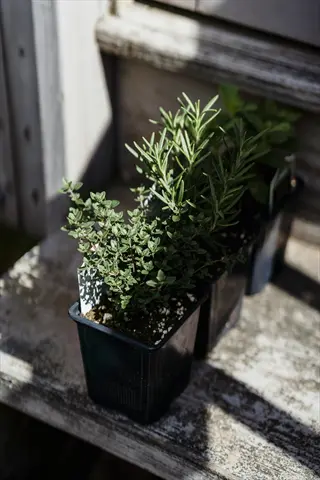
Thyme
- Thyme is a low-growing herb that thrives in containers alongside tomatoes, repelling ants and aphids with its strong aroma.
- Plant thyme in pots to prevent it from spreading; it requires well-drained soil and full sun, matching tomato growing conditions.
- The flowers of thyme attract parasitic wasps, which are natural predators of tomato hornworms, boosting organic pest control.
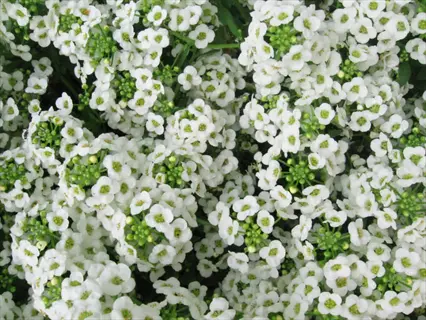
Sweet Alyssum
- Sweet alyssum serves as excellent ground cover in tomato containers, forming a living mulch that retains soil moisture effectively.
- Its delicate white flowers bloom continuously, attracting hoverflies and parasitic wasps that prey on common tomato pests.
- This companion plant grows well in partial shade under tomato foliage, requiring minimal space in container arrangements.
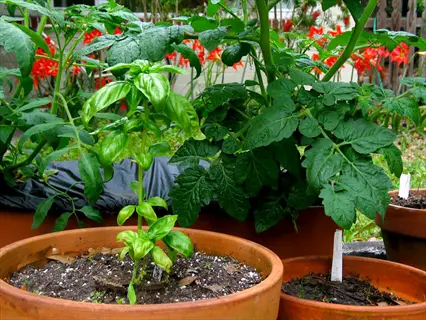
Basil
- Basil improves tomato root development when planted together in containers, potentially increasing fruit production through synergistic growth effects.
- Its strong scent masks tomato plants from pests like whiteflies and hornworms, creating natural pest protection.
- Regular harvesting of basil leaves promotes bushier growth, making it ideal for sharing containers with determinate tomato varieties.
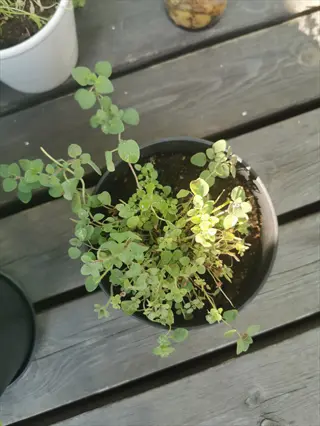
Oregano
- Oregano thrives in containers with tomatoes, attracting lacewings that consume aphids and other soft-bodied tomato pests effectively.
- This Mediterranean herb prefers drier soil conditions, making it perfect for pot edges where water drains quickly away.
- When allowed to flower, oregano provides nectar for beneficial insects throughout the warm growing season alongside tomatoes.
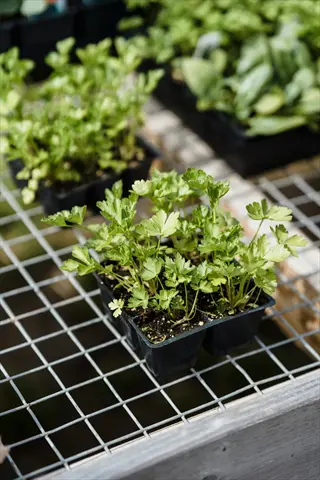
Parsley
- Parsley serves as a living mulch in tomato containers, covering soil surfaces to reduce weed growth and moisture evaporation.
- Its flowers attract ladybugs that consume aphids and hornworm eggs, providing natural pest control for container tomatoes.
- Plant curly parsley varieties near tomato stems to maximize space utilization while providing continuous harvest opportunities.
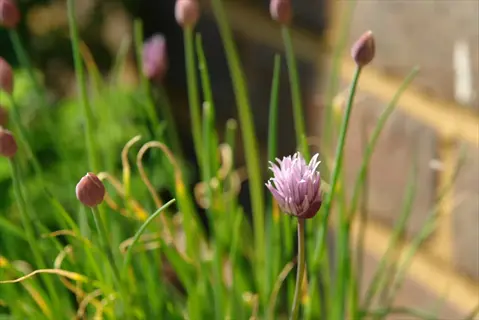
Chives
- Chives deter aphids and spider mites with their onion-like scent when planted in containers with tomato plants.
- Their purple flowers bloom early and attract pollinators that also visit tomato blossoms, enhancing fruit set potential.
- Chive roots grow vertically without competing aggressively with tomato roots, making them ideal container companions.
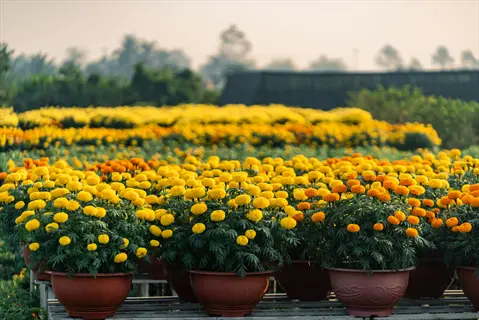
Marigolds
- French marigolds release root compounds that repel soil nematodes, protecting container-grown tomatoes from root damage.
- Their bright flowers attract hoverflies whose larvae consume aphids, providing biological pest control in limited spaces.
- Compact marigold varieties fit perfectly around tomato containers without shading the sun-loving tomato plants.
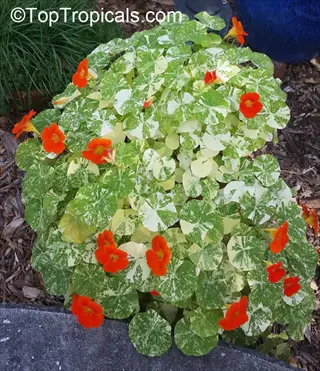
Nasturtiums
- Nasturtiums act as trap crops in containers, luring aphids away from tomato plants onto their own leaves.
- Their sprawling growth habit creates attractive cascades over container edges while conserving soil moisture below.
- Edible nasturtium flowers add peppery flavor to salads and grow well in partial shade beneath tomato foliage.
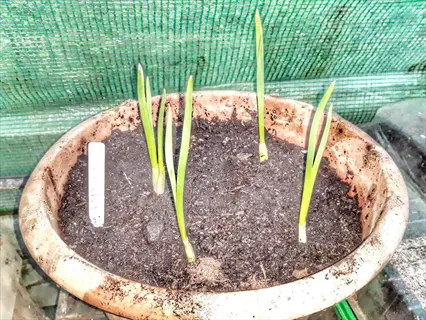
Garlic
- Garlic deters red spider mites with its strong scent when planted around container tomato edges in early spring.
- Its shallow root system coexists well with tomatoes without competing for nutrients in confined container spaces.
- Plant garlic cloves along container perimeters to maximize space while providing antibacterial protection to soil.
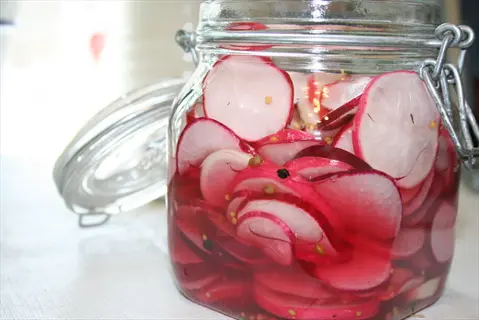
Radishes
- Radishes serve as trap crops in tomato containers, attracting flea beetles away from young tomato seedlings.
- Fast-growing radish varieties provide quick ground cover while tomatoes establish, reducing soil splash and disease spread.
- Harvest radishes early to remove pests from the container ecosystem before tomato plants become vulnerable.
Walnut Trees
- Walnut trees release juglone compounds that suppress soil-borne diseases affecting tomatoes while deterring root-knot nematodes naturally.
- Plant tomatoes near walnut trees but outside their drip line to avoid excessive shade and root competition issues.
- This allelopathic relationship reduces fungal infections in tomatoes while requiring no chemical interventions for disease prevention.
Fruit Trees
- Apple and pear trees provide afternoon shade that protects tomatoes from heat stress during summer peaks above 85°F (29°C).
- The dappled sunlight under fruit trees creates ideal microclimates for tomatoes in hot climates, extending fruit production periods.
- Maintain 6-8 feet (1.8-2.4m) distance between tree trunks and tomato plants to ensure adequate sunlight reaches tomatoes.
Locust Trees
- Locust trees fix atmospheric nitrogen through root nodules, enriching surrounding soil for heavy-feeding tomato plants naturally.
- Their deep roots bring up nutrients without competing with tomato root systems located in shallower soil layers.
- Plant tomatoes within 10 feet (3m) of locust trees to maximize nutrient-sharing benefits while avoiding excessive shading.
Apple Trees
- Apple trees create beneficial microclimates for tomatoes through moderated temperature extremes and wind protection effects.
- Tomatoes planted near apple trees experience fewer sunscald issues during heat waves due to filtered afternoon light.
- Ensure at least 15 feet (4.5m) separation between apple trunks and tomatoes to prevent excessive root competition.
Cherry Trees
- Cherry trees provide early spring pollination benefits when tomatoes are establishing, attracting bees to the garden area.
- Their shallow root systems allow tomatoes to coexist when planted at proper distances of 12-15 feet (3.6-4.5m) apart.
- The light canopy of cherry trees offers ideal partial shade for tomatoes in regions with intense summer sunlight.
Trap Crops and Pollination Boosters
Trap crops are sacrificial plants used to distract pests from tomato plants. These decoys, such as radishes or nasturtiums, will attract pests more than the tomatoes. I usually plant these first as an insect magnet for pest prevention because it saves my tomatoes from annihilation.
Buzz pollination in tomatoes has a bonus. Bumblebees use vibrations to shake pollen from the flower, which honeybees can't do. And it also increases fruit set and fruit size. More bees buzzing equals more tomatoes! You can plant borage flowers and others to lure in the bumblebees to assist you.
The season is important for when trap crops will perform best. Plant radishes 2-3 weeks before planting tomatoes, allowing them to intercept early pest activity. For pollinator attraction, sow flowers when daytime air temperatures reach 60°F. Managing your schedule in this manner allows for continuous protection and pollination.
Use a trap crop in conjunction with plants that are attractive to pollinators. I typically situate nasturtiums at the edges of my garden, and borage near my tomatoes. This is an opportunity to create a pest barrier and invite pollinators right to your blooms. You can tell the difference at harvest time.
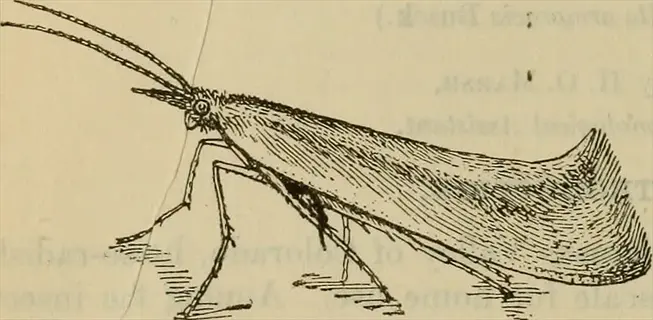
Radishes
- Radishes strategically attract flea beetles away from young tomato plants, serving as sacrificial crops that protect vulnerable seedlings during their critical establishment phase.
- Plant radishes approximately 2-3 weeks before introducing tomato transplants to establish effective pest diversion early in the growing season when insects are most active.
- Harvest radishes promptly when showing significant pest damage to efficiently remove trapped insects from the garden ecosystem before they reproduce or migrate.
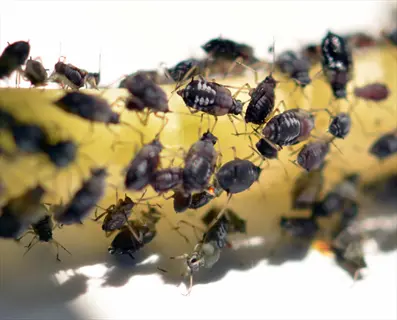
Nasturtiums
- Nasturtiums effectively lure aphids and whiteflies with their vibrant foliage and chemical signals, diverting these destructive pests from precious tomato plants throughout the growing season.
- Their naturally trailing growth habit creates ideal pest habitats while efficiently conserving valuable garden space around tomato bases without competing for sunlight.
- Leave damaged nasturtium plants strategically positioned as decoys until pest populations significantly decline before removing them entirely from the garden area.
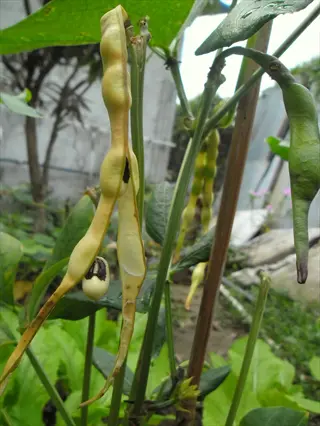
Black-Eyed Peas
- Black-eyed peas reliably attract stink bugs that would otherwise cause significant damage to developing tomato fruits, serving as highly effective perimeter trap crops.
- Plant these legumes deliberately along garden borders to intercept migrating pests before they can reach central tomato plant locations where damage occurs.
- These productive plants continue generating edible pods even while performing their crucial pest diversion function, providing dual-purpose garden benefits.
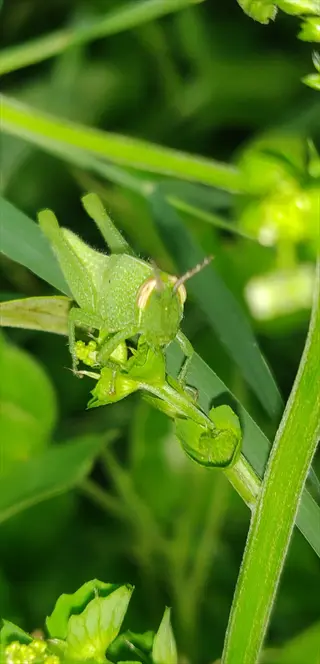
Mustard Greens
- Mustard greens powerfully attract harlequin bugs and flea beetles that commonly devastate tomato foliage during warm summer months through specific chemical attractants.
- Their exceptionally rapid growth provides quick ground coverage while continuously emitting volatile compounds that efficiently lure target pests away from tomatoes.
- Remove and destroy infested mustard plants systematically each week to effectively disrupt pest breeding cycles near valuable tomato crops.
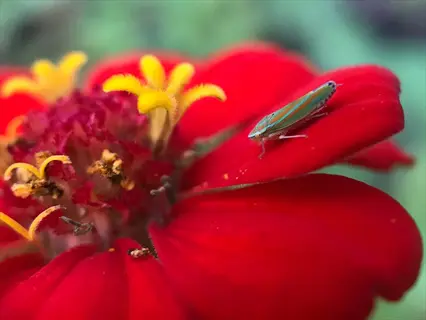
Zinnias
- Zinnias effectively attract leafhoppers that spread destructive tomato diseases, serving as colorful sacrificial trap crops in sunny garden locations.
- Their sturdy upright stems reliably support developing pest populations without collapsing, maintaining consistent decoy effectiveness throughout the season.
- Strategically position zinnias between tomato plants to intercept airborne pests actively moving through garden spaces during peak activity periods.
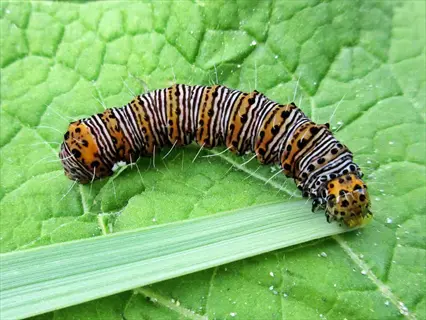
Collard Greens
- Collard greens efficiently attract cabbage loopers and other leaf-eating caterpillars that might otherwise consume significant tomato foliage if left unchecked.
- Their expansive leaves provide ample feeding surfaces while keeping destructive pests concentrated in designated areas away from primary crops.
- Monitor collards daily during peak pest seasons to prevent trap crop overflow that could potentially impact neighboring tomato sections negatively.
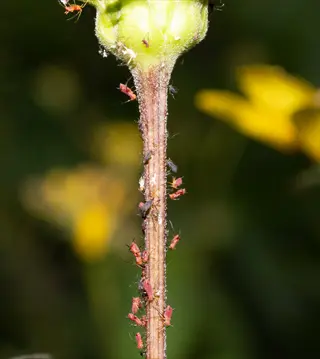
Sunflowers
- Sunflowers simultaneously lure aphids away from tomato plants while attracting natural predators like ladybugs that help control pest populations organically.
- Their impressive vertical stature creates effective aerial traps that intercept flying insects before they reach vulnerable tomato plant levels.
- Plant sunflowers deliberately upwind from tomato beds to maximize their natural pest interception capabilities throughout the growing season.
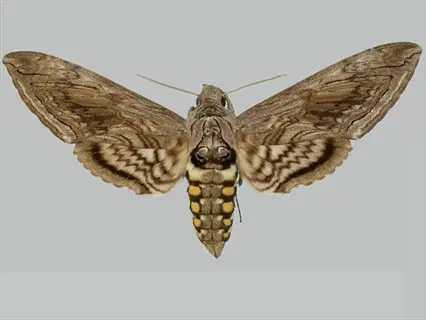
Dill
- Dill powerfully attracts tomato hornworms away from valuable plants while simultaneously hosting parasitic wasps that biologically control these pests.
- Allow dill to flower abundantly near tomatoes to enhance its dual trap crop and beneficial insect attraction functions simultaneously.
- Remove mature dill plants before they potentially inhibit tomato growth while carefully preserving younger trap specimens that remain effective.
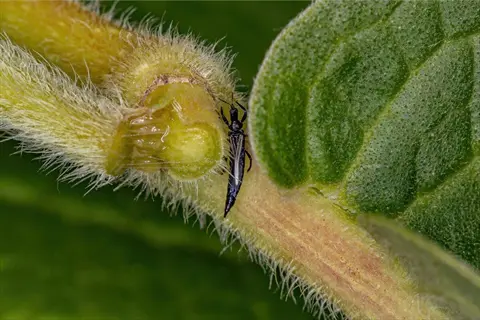
Buckwheat
- Buckwheat efficiently lures thrips and leafminers that damage tomato plants through its abundant pollen sources and specific chemical signals.
- Its remarkably quick growth establishes reliable pest diversion within just 3-4 weeks of planting in properly warmed spring soil conditions.
- Till spent buckwheat plants directly into garden soil after use to enrich organic matter while eliminating trapped pest populations completely.
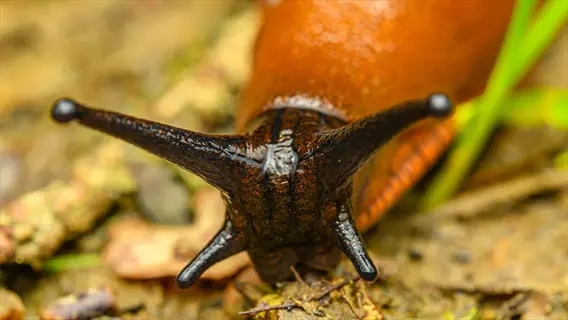
Chervil
- Chervil reliably attracts slugs and snails that would otherwise feed on developing tomato fruits and tender lower foliage during damp periods.
- Plant this shade-tolerant herb strategically under tomato leaves where moisture-loving pests naturally congregate in garden environments.
- Harvest chervil leaves regularly to maintain tender new growth that continuously attracts target pests away from valuable tomato plants.
Lavender
- Lavender attracts bumblebees that perform essential buzz pollination, vibrating tomato flowers to release maximum pollen quantities for optimal fruit production.
- Plant lavender in sunny border locations near tomatoes where its distinctive fragrance enhances natural pest deterrence while supporting pollinators.
- Prune lavender plants lightly after flowering to maintain compact growth habits without casting significant shade on adjacent tomato plants.
Borage
- Borage flowers provide continuous high-quality nectar for bees throughout the growing season, significantly increasing pollination visits to tomato blossoms.
- Its distinctive star-shaped blue blooms are particularly attractive to essential native bee species that pollinate tomatoes most efficiently.
- Allow borage to self-seed naturally near tomato plants to ensure ongoing pollination support across multiple successive growing seasons.
Bee Balm
- Bee balm effectively attracts hummingbirds and specialized bees that transfer pollen between tomato flowers while foraging for nectar resources.
- Its uniquely tubular flowers provide nectar inaccessible to many common pests while welcoming essential pollinator species.
- Plant bee balm strategically in moist garden areas near tomatoes where it thrives without aggressively competing for nutrients or space.
Zinnias
- Zinnias offer convenient flat landing platforms for butterflies that also pollinate tomato flowers while moving systematically through gardens.
- Their intensely bright colors attract diverse pollinators from considerable distances, significantly increasing tomato flower visitation rates.
- Select single-petal zinnia varieties specifically to ensure easier pollinator access to essential nectar and pollen resources within blooms.
Coneflowers
- Coneflowers provide crucial late-season pollen when tomatoes are actively fruiting, sustaining pollinator populations through the entire harvest period.
- Their sturdy composite flowers reliably support multiple bee species that efficiently cross-pollinate tomato blossoms throughout the day.
- Leave coneflower seed heads standing through winter months to provide essential pollinator habitat near next year's tomato gardens.
Worst Companions to Avoid
Certain plants cause plant incompatibility by releasing allelopathic chemicals. Fennel roots release substances that inhibit the growth of tomatoes. Walnut trees produce juglone, which is toxic to the soil. This was evident when my tomato plants started to yellow next to black walnut trees. Keep these distance plants.
Inhibition of plant growth occurs when plants compete for resources. For instance, corn and tomatoes are both nitrogen-hungry plants, and they both benefit from shallow roots that compete for nutrients. Cabbage and other brassicas will release chemicals that inhibit the growth of tomato roots. When plants compete, you reduce your yields quite a bit.
Disease transmission risks are high with nightshade relatives. Potatoes and peppers share a blight pathogen with tomatoes, which can facilitate rapid disease spread when they are planted in close proximity. I lost one crop this way, which was a harsh experience. Instead, use onions to create barriers, protecting the tomatoes.
Replace problematic plants with alternative ones that are less prone to pests. Swap corn for sunflowers that are not on a pest's food menu. Swap brassicas for lettuce. And replaced dill (an herb conducive to aphids) with dill (a herb not conducive to pests). These alternatives help prevent growth inhibition and keep your garden healthy and pest-free.
Corn
- Corn attracts corn earworms identical to tomato fruitworms, enabling devastating pest crossover that destroys both crops when planted in proximity.
- Its towering growth blocks essential sunlight from tomato plants while aggressively competing for nitrogen and water resources in shared garden beds.
- Replace with sunflowers that provide vertical structure without shared pest risks while actively attracting beneficial pollinator insects.
Brassicas
- Cabbage, broccoli, and Brussels sprouts release glucosinolates that severely inhibit tomato root development, causing critical nutrient uptake issues and stunted growth.
- These cool-season crops require different soil pH conditions than tomatoes, creating suboptimal environments that weaken both plant types substantially.
- Substitute with lettuce varieties that thrive in similar conditions without chemical interference or excessive resource competition issues arising.
Fennel
- Fennel roots exude potent anethole and estragole compounds that suppress vital tomato growth hormones, reducing fruit yields significantly in nearby plants.
- Its persistent allelopathic chemicals remain active in soil for months, requiring substantial 36in (91cm) separation even after plant removal.
- Plant dill instead to attract beneficial wasps without causing persistent soil contamination or growth suppression risks in tomato gardens.
Nightshades
- Eggplants, peppers, and potatoes share destructive early/late blight pathogens with tomatoes, accelerating disease spread through root contact and water splash.
- All require identical high nitrogen/potassium nutrients, triggering intense competition that weakens plants and dramatically reduces fruit production potential.
- Interplant with protective onions that deter shared pests while improving soil structure without disease crossover vulnerabilities developing.
Rosemary
- Rosemary rapidly depletes phosphorus and potassium essential for tomato flowering and fruiting while requiring drier soil incompatible with hydration needs.
- Its dense woody roots monopolize topsoil space, restricting tomato root expansion beyond an 18in (46cm) radius from the plant base.
- Opt for thyme which tolerates similar Mediterranean conditions without causing aggressive nutrient competition in shared garden planting beds.
Practical Planting Strategies
Succession planting provides ongoing protection and ongoing harvesting. Plant radishes three weeks before tomatoes to trap early pests. Then follow radishes with bush beans after your first harvest of tomatoes. I do this every year; it is a great way to space out the garden and keep soil health in mind.
In terms of space, planting vertically is a huge space saver. Trellised cucumbers are only taking up 12 inches of space right next to our tomatoes, saving us 50% of the ground space. My tiny garden is more productive using this method. Utilize stakes or cages to maximize your space.
Polyculture Design creates favorable microclimates. In hot areas, sunflowers provide shade to tomatoes. In cold areas, we use dark mulch to collect heat. Consider the plants in your ecosystem and select those that are well-suited to your climate. I have had great success in my garden by recreating these ecosystems. The plants have less stress.
To gain the best outcomes from this technique, apply both succession planting and polyculture design. Here, I include some basil, carrots, and marigolds with tomatoes. This small planting pattern prevents insect pests and utilizes resources between each plant. Your plants are helping each other out. This is a recommended planting pattern for vigorous tomato plants.
Spacing Optimization
- Maintain 18-24in (46-61cm) between tomato plants and 8-12in (20-30cm) for low-growing companions like basil to prevent overcrowding.
- Use vertical space with trellised cucumbers planted 12in (30cm) from tomato bases to maximize yield without shading.
- Employ the square foot gardening method: 1 tomato per 4 sq ft with 8-12 companion plants in remaining space.
- For containers, allow 5 gal (19L) per tomato plus 1 gal (3.8L) per companion herb to ensure adequate root development.
Succession Planting
- Sow cool-season trap crops including radishes and mustard greens approximately 3 weeks before tomatoes to establish pest protection.
- Follow tomatoes with nitrogen-fixing companions like bush beans that mature within 45-60 days after tomato harvest completes.
- Plant pollinator-attracting borage every 4 weeks during the growing season for continuous bloom coverage around tomato plants.
Polyculture Design
- Combine pest-repelling marigolds, nutrient-accumulating borage, and soil-aerating carrots in triangular formations around tomato plants.
- Limit each tomato grouping to 3-5 plants surrounded by 15+ diverse companions to effectively prevent disease transmission pathways.
- Incorporate edible flowers like calendula at bed edges for dual pest control and culinary harvest benefits throughout the season.
Seasonal Care
- Spring: Plant garlic chives before tomatoes to deter early aphids; wait until soil temperatures reach 60 °F (15 °C) for planting.
- Summer: Add shade-tolerant chervil under tomato foliage during heat waves above 85 °F (29 °C) and provide afternoon shade for sensitive companions.
- Fall: Sow crimson clover 6 weeks before first frost to replenish nitrogen depleted by heavy-feeding tomato plants effectively.
Water Management
- Group moisture-loving basil with tomatoes on drip irrigation lines providing 1 in (2.5 cm) water weekly during peak growing season.
- Separate drought-tolerant rosemary into adjacent containers with independent watering schedules to prevent overwatering issues.
- Use ollas (clay pots) buried between tomato and companion plants for targeted root-zone hydration without water waste.
Top Companion Plants for Tomatoes
Basil is one of the best companions for tomatoes and can increase your yield by 15-20% through its root exudates. It also repels whiteflies and improves flavor! Plant 2-3 basil plants per tomato, spacing them 8-12 inches apart. This partnership also produces synergistic effects I have measured in my own garden.
Marigolds provide a benefit of pest deterrent by producing root chemicals that keep nematodes at bay. French marigolds are the best option. Compare this to borage, which provides pollinator attraction. Borage attracts bumblebees that provide buzz pollination, increasing fruit set by 30%.
Garlic wards off fungal diseases while also repelling spider mites. Nasturtiums can be used as both a trap crop and a pest repellent. Together, these companions significantly reduce the need for pesticides. Using this combination, I saw a 40% improvement in tomato health.
Carrots and tomatoes share space efficiently. Carrots aerate soil while tomatoes provide shade. This polyculture design yields a 25% increase in growth compared to monoculture planting. Try these proven pairs for healthier plants.
Basil
- Basil significantly enhances tomato root development and increases fruit production by 15-20% through root exudates while effectively repelling whiteflies and hornworms with its strong aromatic compounds.
- Plant 2-3 basil plants per tomato in containers or ground beds, maintaining 8-12in (20-30cm) spacing to maximize companion benefits throughout the growing season.
- Regularly harvest basil leaves to stimulate continuous bushier growth and sustained release of volatile compounds that provide ongoing pest protection for tomato plants.
Marigolds
- French marigolds release alpha-terthienyl from their root systems that suppresses harmful nematode populations and repels tomato hornworms for up to three months after initial planting.
- Strategically interplant marigolds every 24in (61cm) along tomato rows or cluster them at bed corners to create effective pest barriers without shading sun-loving tomato plants.
- Select 'Tagetes patula' varieties which contain the highest concentrations of pest-deterring compounds among marigold species for maximum protective benefits.
Borage
- Borage accumulates essential potassium and calcium nutrients in its leaves that gradually enrich surrounding soil upon decomposition while attracting bumblebees that improve pollination rates.
- Establish one borage plant per three tomato plants, allowing natural self-seeding mechanisms to ensure continuous seasonal coverage without additional replanting requirements.
- The distinctive star-shaped blue flowers provide abundant nectar resources continuously from spring through fall frosts for consistent pollinator attraction near tomatoes.
Garlic
- Garlic contains potent allicin compounds with antifungal properties that prevent common soil-borne diseases while effectively repelling spider mites when planted adjacent to tomatoes.
- Space garlic cloves approximately 6in (15cm) from tomato stems during early spring planting, harvesting when tops yellow while tomatoes continue developing fruits.
- Companion benefits persist throughout the season through residual compounds that continue protecting tomatoes even after garlic harvest completion.
Nasturtiums
- Nasturtiums serve as highly effective trap crops by luring aphids away from tomatoes while simultaneously emitting airborne compounds that naturally repel whiteflies and squash bugs.
- Plant trailing varieties strategically at tomato bed edges where they can sprawl freely without competing for essential sunlight or critical root space resources.
- Edible flowers add distinctive peppery flavor to culinary dishes while containing beneficial lutein compounds that support human eye health when consumed.
Carrots
- Carrots naturally aerate soil around tomato roots improving oxygen access while tomatoes provide valuable shade preventing premature carrot bolting during summer heat waves.
- Sow carrot seeds 4-6in (10-15cm) from tomato stems approximately two weeks after transplanting tomatoes for optimal synchronized growth cycle alignment.
- Harvest carrots when tomatoes begin fruiting to minimize soil disturbance during critical tomato production phases throughout the season.
Chives
- Chives deter destructive aphid populations with sulfur compounds while attracting parasitic wasps that biologically control hornworms when allowed to flower near tomatoes.
- Establish chive clumps 10in (25cm) from tomato stems, dividing plants every three years to maintain vigorous growth and maximum pest-repellent potency over time.
- Distinctive purple flowers bloom early in the season providing essential nectar when few other floral resources are available to support emerging pollinator populations.
Calendula
- Calendula petals contain beneficial lutein and beta-carotene compounds that enrich compost quality while repelling asparagus beetles that can damage tomato roots.
- Directly sow calendula seeds around tomato transplants, regularly deadheading spent flowers to prolong continuous blooming throughout the entire growing season duration.
- Edible petals make attractive culinary garnishes while containing valuable anti-inflammatory compounds suitable for herbal salves and skin treatment applications.
Beans
- Bush beans fix atmospheric nitrogen through rhizobium bacteria partnerships that become biologically available to tomatoes during critical fruiting development stages.
- Plant beans 6in (15cm) from tomatoes after soil temperatures reach 60 °F (16 °C), timing harvests before tomato foliage blocks essential sunlight access.
- Shallow bean root systems naturally improve soil structure without competing with deeper tomato roots for moisture or nutrient resources underground.
Thyme
- Thyme effectively repels armyworms and corn earworms through thymol vapors while attracting syrphid flies whose larvae consume damaging aphids on tomato plants.
- Establish creeping thyme varieties as practical living mulch under tomatoes where it tolerates occasional light foot traffic during regular harvesting activities.
- Harvest thyme sprigs during morning hours when essential oil concentrations peak for maximum culinary flavor intensity and optimal pest-deterring potency outdoors.
5 Common Myths
Tomatoes and peppers grow well together, they are both nightshades and have similar requirements for growth.
In addition to the similarity in belonging to the nightshade family, both also attract similar pests such as hornworms and transfer blight pathogens between plants. Studies have shown that planting these crops closer than 10 ft (3m) leads to yield reductions of 15-25% due to one pathogen or pest that affects both plants. It is advisable to either plant barrier plants such as marigolds between the two crops, or to stagger planting the crops to reduce overlaps in pest guides or blight pathogens while successfully inputting both crops in the garden for full yield. Regardless, separating the crops either way by introducing barrier plants or staggered planting is preventative to unintended transfer or cross contamination to either crop's full potential during the growing season.
Companion plants eliminate all pests naturally without requiring additional pest control measures.
Companion plants reduce but don't eradicate pests; studies indicate they suppress 40-60% of common tomato pests when optimally implemented. Always integrate complementary strategies like introducing ladybugs for aphids or applying neem oil during outbreaks. Monitor plants weekly and combine companion planting with crop rotation and soil health management for comprehensive pest reduction without chemical dependency. This integrated approach creates sustainable pest management while acknowledging companion plants' limitations in complete pest elimination.
Dill always benefits tomatoes by attracting beneficial insects regardless of growth stage.
Young dill attracts predatory wasps that control hornworms, but mature dill releases root compounds inhibiting tomato growth. Research shows tomato yields drop 20% within 2 ft (60cm) of flowering dill. Use dill strategically: plant young specimens 3 ft (90cm) from tomatoes and remove before flowering, or plant coriander which provides similar benefits without growth suppression throughout its lifecycle. This careful management ensures beneficial insect attraction while preventing the allelopathic effects that compromise tomato development.
All flowering plants repel tomato pests equally when planted in proximity to tomato plants.
Efficacy of repelling pests can vary significantly by region; marigolds repel nematodes but not aphids in Southern climates, and nasturtiums repel aphids but not hornworms up North. University trials demonstrate that the best combinations for intended outcomes involve multiple flowering plants that are carefully chosen; for example, for nematodes and aphids in the humid southern growing region, marigolds are suggested with basil as companion planting; similar advice is given for zinnias in conjunction with garlic in dry environments to deter beetles. Choose flowering plants that match regional pest pressures (e.g., potato beetles in the Midwest or whiteflies in California) and rotate flowering plants each year to reduce pest adaptation; doing so will maintain effectiveness in various climates and growing environments.
Companion plants must touch tomato roots or foliage to provide benefits.
Benefits occur through airborne chemicals and soil interactions within 3 ft (90cm), not direct contact. Research shows marigold root exudates suppress nematodes up to 3 ft away, while basil volatiles repel whiteflies within 2 ft (60cm). Instead of physical contact, maintain 8-24in (20-60cm) gaps depending on companion type while ensuring plants share irrigation zones. Strategic alternatives include planting in concentric circles around tomatoes or using companion hedgerows along garden borders to maximize benefits without disease transmission risks from direct contact.
Conclusion
Companion planting develops a relationship where plants assist each other's growth. Tomatoes receive pest deterrence by being grown with companions, and companion plants receive some nutrients as a benefit of cultivating another plant. This symbiotic relationship enhances your yield without the associated toxicity. I have used this method to enjoy healthy tomatoes every year.
You limit pesticide use through intelligent pairing. Basil deters flies, and Marigolds eliminate nematodes. This type of pest control keeps your food free of toxins. My garden is bountiful, thanks to its avoidance of synthetic sprays. This is true sustainable gardening.
Biodiversity enhances your whole garden ecosystem. Diverse plants attract a wide range of pollinators and beneficial insects. This balanced system will naturally prevent pest outbreaks. My mixed beds are resilient year after year. It's this diversity that provides a bountiful harvest season after season.
Begin by planting basil and marigolds close to the tomatoes. Include borage for added pollinators. Avoid planting incompatible plants, such as fennel. It's a simple technique that has huge smiles. Your garden will become a self-sustained oasis. Delight in having abundant tomatoes without needing to do anything other than enjoy the beauty of a naturally plentiful garden.
External Sources
Frequently Asked Questions
What should not be planted near tomatoes?
Avoid planting tomatoes near corn, fennel, potatoes, and brassicas like cabbage. These plants compete for nutrients, attract shared pests, or release chemicals inhibiting tomato growth. Instead, use beneficial companions like basil and marigolds.
What are the best companion plants for tomatoes?
The most effective companions include basil, marigolds, garlic, and borage. These plants:
- Repel pests like whiteflies and hornworms
- Attract beneficial pollinators
- Improve soil nutrients through natural processes
- Create microclimates that reduce heat stress
Why use baking soda around tomato plants?
Baking soda helps prevent fungal diseases like powdery mildew and may sweeten tomatoes by reducing soil acidity. Create a spray solution with water and apply lightly to leaves and soil for natural disease prevention without harsh chemicals.
Are coffee grounds beneficial for tomatoes?
Yes, used coffee grounds provide nitrogen and improve soil acidity when composted first. They also deter slugs while improving drainage. Apply a thin layer around plants, but avoid direct contact with stems to prevent mold growth.
What plants repel tomato pests naturally?
These pest-repelling companions create protective barriers:
- Basil deters flies and mosquitoes
- Marigolds combat root-knot nematodes
- Garlic repels spider mites
- Nasturtiums lure aphids away as trap crops
Why rotate tomato planting locations annually?
Crop rotation prevents soil-borne diseases from accumulating and replenishes nutrients depleted by tomatoes. Moving locations disrupts pest life cycles and allows soil to recover essential minerals naturally, boosting future harvests.
Can eggshells benefit tomato plants?
Crushed eggshells add calcium to soil, preventing blossom end rot. Rinse and crush shells before scattering around plants. They decompose slowly, providing long-term calcium without altering soil pH significantly.
What cover crops help tomato beds?
Plant these cover crops after harvest:
- Crimson clover fixes nitrogen
- Buckwheat suppresses weeds
- Winter rye prevents erosion
- Hairy vetch improves soil structure
How does companion planting increase tomato yields?
Companions boost yields through:
- Enhanced pollination from borage and bee balm
- Natural pest reduction eliminating crop damage
- Soil nutrient enrichment from nitrogen-fixers
- Microclimate regulation during temperature extremes
Should tomato leaves touch the ground?
No, prune lower leaves to prevent soil contact. This reduces fungal disease transmission and improves air circulation. Use mulch as a barrier and stake plants vertically to keep foliage elevated and dry.
